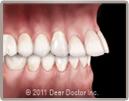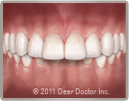It can feel like you’re learning to speak a different language when you’re talking to any kind of medical or dental specialist. Here is a quick primer on some of the terms commonly used by orthodontists.
Anterior Teeth: Front teeth.
 Crossbite: One or more upper teeth fit behind the lower teeth, instead of in front of those teeth. It’s extremely important this condition be identified and corrected because it can alter skeletal growth.
Crossbite: One or more upper teeth fit behind the lower teeth, instead of in front of those teeth. It’s extremely important this condition be identified and corrected because it can alter skeletal growth.
 Overbite: One or more upper teeth come down too low over the bottom teeth. Too much overbite is often called a “deep bite.”
Overbite: One or more upper teeth come down too low over the bottom teeth. Too much overbite is often called a “deep bite.”
 Open Bite: The upper and lower teeth don’t touch. An anterior open bite is when the front teeth don’t touch and is often the result of thumb-sucking.
Open Bite: The upper and lower teeth don’t touch. An anterior open bite is when the front teeth don’t touch and is often the result of thumb-sucking.
Buccal: The side of the mouth closest to the cheek.
Palatal: The side of the mouth closest to the roof of the mouth.
Lingual: The side of the mouth closest to the tongue.
Occlusion: How the teeth fit together between the upper and lower jaws. Ideally, the upper teeth fit slightly over the lower teeth, so the points of the upper molars fit the grooves of the lower molars. This gives you a good bite.
Malocclusion: You have a malocclusion when the teeth are not fitting together properly. Common types of malocclusions include crowding, gaps between teeth, crossbite, overbite, underbite and open bite.
Class I Occlusion: Your back teeth are properly aligned and allow for ideal chewing.
Class II Occlusion: Your upper teeth are too far forward compared to your lower teeth, or your bottom teeth are too far back compared to your upper teeth and jaw. This condition makes it look like you have a very small lower jaw or a "weak chin."
 Class II, Division 1: Your upper middle front teeth, called the central incisors, flare out over your lower teeth, resulting in an overjet. This condition is also known as buck teeth.
Class II, Division 1: Your upper middle front teeth, called the central incisors, flare out over your lower teeth, resulting in an overjet. This condition is also known as buck teeth.
 Class II, Division 2: Your upper side front teeth, called the lateral incisors, are too far forward and the central incisors are far back over your lower teeth, often resulting in crowding and an overbite. This condition is also known as a deep bite.
Class II, Division 2: Your upper side front teeth, called the lateral incisors, are too far forward and the central incisors are far back over your lower teeth, often resulting in crowding and an overbite. This condition is also known as a deep bite.
 Class III Bite: Your lower teeth are further forward than your upper teeth. This condition is called an underbite. This condition makes it look like you have a very prominent chin.
Class III Bite: Your lower teeth are further forward than your upper teeth. This condition is called an underbite. This condition makes it look like you have a very prominent chin.
Phase I Treatment: Early interceptive orthodontic treatment for children between the ages of 6 and 10. Phase I Treatment takes place while the child has a mix of baby teeth and permanent teeth. Phase I treatment helps properly form the jaw and allows the erupting permanent teeth to be guided into their proper position. This places the teeth in a much more stable position than allowing the teeth to come in crooked, and can prevent bigger orthodontic problems from developing. While Phase I treatment can help with many orthodontic problems, it’s common to still need Phase II treatment once all the permanent teeth have come in.
Phase II Treatment: This type of treatment is recommended when all of the permanent teeth have come in. It often involves braces and occasionally involves additional appliances to straighten the permanent teeth and properly align the jaws. Some Phase II cases can be treated with clear aligner therapy, such as Invisalign® or ClearCorrect™, instead of conventional braces.
For more information about orthodontic conditions and treatments, please visit our orthodontics section. There you will find pictures and videos that further explain how braces, aligners and other orthodontic tools fix smiles.
Reviewed by: Cindy Roark, DMD